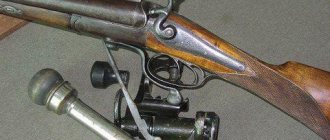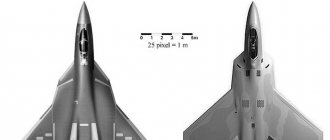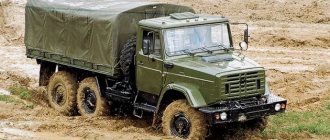For use in agriculture and forestry, industry and transport, the Gorky Automobile Plant produced more than 4 million GAZ-53 units. Based on the chassis of models 53F, 53A and 53-12, trucks for various purposes were produced: fire engines, vacuum trucks, milk tankers, sewage tanks, vans and buses. GAZ-5319 and 5327 operated on liquefied and compressed gas. The GAZ-53 dump truck was produced in 1966-74, was labeled GAZ-SAZ-53B and was intended for transporting bulk materials on various roads.
Dump truck GAZ-SAZ 53B
The dump truck has a shortened frame by 300 mm, which is why the spare wheel was moved under the body behind the driver. Both suspensions are on leaf springs, shock absorbers are installed only on the front suspension. On the first releases of trucks, the edges of the main sheets were bent and formed an “ear” for fastening, and at this point they were fastened through the bushing using spring pins.
The gasoline tank is located under the driver, the filler neck is located immediately behind the driver's door. The modification was carried out from 1966 to 1984; in addition to Saransk, cars with dumping equipment were produced at the Frunzensky Automobile Assembly Plant.
The most famous truck from the times of the USSR is considered to be the GAZ-53, in addition, it also surpassed its counterparts in terms of production quantity. GAZ-53 can be classified as a medium-tonnage truck.
The GAZ-53 truck has rear-wheel drive, and various modifications of trucks were produced on its basis, including dump trucks. GAZ 53 dump trucks were marked as GAZ-SAZ 53B. GAZ 53 dump trucks were produced from 1966 to 1974.
Cabin
The dump truck cabin has space for two people. Such a dump truck could load 3.5 tons, despite the fact that the weight of the equipped dump truck reached 3 tons 750 kg. The dump truck was 6.38 m long, 2.475 m wide, and 2.575 m high. Its wheelbase reached 3.7 m.
Engine
Like all 53 models, the GAZ 53 dump truck was equipped with a carburetor engine that could run on both natural gas and gasoline. The engine was installed V-shaped with eight cylinders. The engine consumed 24 liters per 100 km, which is not so much for trucks of that time.
V-shaped engine for the GAZ 53 dump truck.
The total engine volume was 4.25 liters, and the power that it could develop was 115 hp.
Transmission
The gearbox is mechanical, consisting of four stages. The GAZ 53 dump truck was equipped with a single-plate dry clutch and a single hypoid final drive. The steering was equipped with a pair of globoid worms with a three-ridge roller. The tire diameter was 20 inches.
Cabin GAZ-53
“A comfortable 2-seater closed cabin, convenient location of controls and instruments, good visibility, reliable brakes, and the presence of powerful lights ensure ease of driving and safety at high speeds at any time of the day,” this is how the GAZ-53 information album described “ VneshTorgIzdata" in 1968.
Well, as they say, what to compare with. From the perspective of our time, the cabin of the GAZ-53 is more than ascetic and spartan.
However, compared to the same GAZ-51, which did not have synchronizers in the gearbox, the clutch had to be depressed 2-3 times before engaging, and the cabin was cramped and poorly heated, the 53rd was simply the pinnacle of comfort!
The two-seater shared sofa seat, covered in faux leather, could easily accommodate three people if desired. The only point: the one who got the seat in the middle could interfere a little with the driver by touching the gearshift lever with his feet. There was also ample space in the cabin for the “creativity” of tuning enthusiasts: Soviet-era drivers decorated their GAZ-53 cabs as best they could.
There were also craftsmen who made homemade insulation and soundproofing of the cabin: they filled it with foam plastic, lined it with felt, achieving amazing silence and comfort in their workplace.
Saransk dump truck plant
The Saransk plant has been operating since 1960, since August. By the end of the first year of its existence, the company had assembled about 10 thousand dump trucks. The plant constantly exceeded the plan and was in good standing, and by 1965 it had already produced its 100,000th dump truck. In the first years, the GAZ-SAZ 53B model rolled off the assembly line; in parallel, the SAZ 3502 model was produced with one-sided unloading of the body and its preliminary lifting. By November 1978, the company had already assembled half a million cars.
Car GAZ-SAZ-3507
Since the beginning of 1984, the Saransk plant has mastered the production of the new GAZ-SAZ-3507 truck. Subsequently, its modifications were developed:
- GAZ-SAZ-35071 with a diesel engine D-245 (based on the GAZ 3309);
- GAZ-SAZ-3507-01 with a ZMZ-5231 gasoline engine (based on the GAZ 3307);
- GAZ-SAZ-25041 with tilting only backwards and preliminary lifting of the body.
Characteristics of the GAZ 33072 chassis
For the GAZ-SAZ-3507-01 model, the basis was the chassis of the GAZ 33072 dump truck. The technical characteristics of the chassis are as follows:
- Engine – ZMZ 5231 (gasoline), eight cylinders, V-shaped;
- Engine power – 125 hp. With.;
- Number of seats in the cabin – 2 (including the driver);
- Load capacity – 4.25 tons;
- Constant maximum speed – 90 km/h;
- Wheel drive – rear (4x2);
- Wheelbase - 3.77 m;
- Fuel consumption per 100 km at a speed of 60 km/h – 19.6 l;
- The weight of a fully loaded vehicle is 7.94 tons;
- Curb weight - 3.6 tons;
- Vehicle dimensions (length/width/height) – 6.47/ 2.4/ 2.46 m, height with extended sides – 2.88 m;
- The fuel used is A-80 gasoline.
Reviews from drivers and owners of GAZ-53
By the way, what do people who have had the opportunity to work on the main medium-tonnage truck of the Union republics and socialist countries say? What advantages and disadvantages will they highlight in this car?
Of the advantages, the first place is the simplicity of the design and direct operation of the machine. On the second - amazing maintainability. To eliminate any minor or major breakdown, no special devices, equipment or tools are required; you don't need to be a qualified specialist. To completely overhaul the engine and gearbox, a couple of days will be enough.
Another undoubted advantage is the durability of the machine during its “killer” operation in extreme conditions. Extremely strong chassis: everything around can “rot” and crumble from old age, but the GAZon hubs and bridges will remain.
“The rear axle is a part that has never been repaired at all, and no one has ever changed the oil there since 1984,” shares his impressions of the owner of a GAZ-53, who to this day uses it (already converted to gas) in his farm, there is practically no corrosion, everything is intact.”
Indeed, one can only speak in superlatives about the quality of the metal of LAWNs produced in the 80s. On the next generation of trucks, the metal was much worse, much more susceptible to corrosion and less durable.
In general, the average period of active operation of a truck could be different - depending on the conditions in which it had to work and the total mileage. On collective farms, where perhaps the most significant part of the 53s “served,” the truck worked for an average of 12 years before being written off.
The capabilities of the GAZ-53 engine were very limited, and it really could not carry more than the 4-4.5 tons required by the passport. Although, naturally, they tried to overload it often, everywhere and everywhere.
For example, with extended sides, grain was loaded from a combine up to seven tons at a time (instead of four and a half). But with great difficulty the engine power was enough to cope with the high load. A lawn that is loaded “to the fullest” or “with allowance” pulls very poorly, even up a not very steep hill you need to “climb” in first gear, and the engine also begins to overheat.
Under conditions of merciless operation, GAZ-53 engines operated for only 100-150 thousand kilometers before the first major overhaul; where conditions were more favorable - and 400 thousand. The engine overhaul could be done at least three times.
The weak point in the LAWN design is the clutch disc; the splines are only enough for one season of intensive work. The support bearing in the crankshaft also did not always last more than a season; Problems with the release bearing are also noted.
The steering is mechanical, tight, and sometimes hits your hands. But there was no talk of any amplifiers in those days. Another disadvantage - high fuel consumption - was also insignificant in the Soviet era.
Now it’s hard to imagine, but then gasoline was cheaper than mineral water: in the 70s, 6-8 kopecks per liter; in the 80s it was already more expensive, but even then the absolute maximum cost of gasoline was 30 kopecks per liter. Therefore, GAZ-53, converted from gasoline to gas, has already become the “child of perestroika.”
Modern GAZ-SAZ dump trucks
In 2003, the plant in Saransk began production of the new model GAZ-SAZ-35072. The base chassis was the GAZ 3309, and its power unit was a Belarusian-made diesel engine D-245. This version of the dump truck turned out to be very economical - fuel consumption according to technical characteristics was 14 liters per 100 km at a speed of 60 km/h.
Dump truck based on GAZ 53 with preliminary lifting of the platform
Despite the fact that the diesel engine has half as many cylinders as the gasoline ZMZ, the power of the D-245 is slightly less. Dump trucks GAZ-SAZ-35071 and GAZ-SAZ-35072 are still produced by the Saransk plant, and these products are deservedly popular.
About the history of the legendary truck and its features
Unlike all previously developed trucks of the Country of Soviets, the GAZ-53 was originally created purely for the needs of the national economy. In case of war, it was not planned to mobilize it into troops and use it to transport guns, transport ammunition, wounded, etc. army needs. In this regard, the GAZ-53 can rightfully be called the first domestic “NOT dual-use” truck.
This explains the “cheerful” colors of the legendary car. If previously all trucks of the Soviet Union were painted only in a dark green protective color, then the 53rd from the very beginning was distinguished by a very diverse range of colors: its cabs were painted in blue, gray, blue, beige, red, green, yellow, orange and some others colors.
The direct “relative” and “ancestor” of the GAZ-53 was another all-Union hard worker - the GAZ-51 truck. The development of a new generation truck was led by the chief designer of the Gorky Automobile Plant, Alexander Dmitrievich Prosvirnin (1914-2005). By the way, he was in 1946-1947. participated in the development of the GAZ-51, then still in the role of an ordinary designer.
During the summer/autumn of 1961, a pilot batch of GAZ-53F trucks was subjected to serious tests, the main of which was a motor rally along the route Moscow - Tashkent - Moscow, with a total length of ten thousand kilometers. The trucks were driven intensively along country roads and real deserts, steppe sands, marshy soils and mountainous areas. The culmination of the route in Central Asia was the Shahristan pass, in Tajikistan, located at an altitude of more than 3.2 thousand meters above sea level.
At the same time, 2 GAZ-53Fs were mercilessly exploited in the Moscow region, in off-road rural conditions, and 4 more were driven along the Moscow-Gorky highway back and forth until the figure of 15,000 km was reached on their speedometer, testing reliability on main lines. In total, each of the vehicles performed 18 flights.
By the way, the “sibling” of the 53rd GAZon, the GAZ-52, also deserves kind words. Also a bestseller, with a circulation of more than 1 million units. This is practically its “twin”. Since the only reliable difference between these models is the model of the installed engine: on the 52nd there is a six-cylinder in-line, on the 53rd there is a more powerful eight-cylinder V-shaped.
By the way, according to the observations of experienced GAZON drivers, the 52nd was distinguished by slightly better cross-country ability in severe off-road conditions or deep snow. The more powerful and resourceful GAZ-53 was more likely to bury itself in mud, snow or sand where the 52nd was slowly passing on its own.
Externally, it was possible to distinguish the GAZ-52 from the GAZ-53 by the wheel rims: the GAZ-52 and modifications had smaller rims, with 6 ventilation holes and narrower tires. The GAZ-53 has wider (and, accordingly, more “load-bearing”) tires; wheels of a larger diameter, with three holes placed at an angle of 120 degrees. However, the rims on the 52nd and 53rd GAZon are interchangeable.
Purchase of a GAZ-SAZ dump truck
GAZ dump trucks are in great demand; through advertisements you can find many used cars of different models and years of manufacture. For example, a GAZ-SAZ 53B can be bought in the range from 50 to 120 thousand rubles, and in excellent condition they ask for up to 200 thousand rubles. GAZ-SAZ-3507 is already more expensive - from 100 to 300 thousand rubles. depending on condition and year of manufacture.
Modification of the GAZ SAZ-3507 dump truck
And the price of the SAZ 35071 produced in 2014 reaches one million rubles.
There are copies of GAZ-SAZ 53B that are sold in good condition, but the cars do not have documents, the price of such cars is from 30 to 50 thousand rubles. There are often advertisements for the purchase of documents from dump trucks from the Saransk plant - there are many who want to restore a car in good condition with a lost title. You can also find PTS for sale through advertisements on the Internet; on the popular Avito resource there are many different offers throughout Russia.
Model 53 12
The truck is designed to transport cargo weighing up to 4,500 kg on asphalt and dirt roads. The machine allowed operation at temperatures from +40 to -40º C.
Option 53 12 is a deep modernization of the 53A model with better indicators in terms of fuel economy, repair regulations and safety.
Increasing the power of the power plant and the use of new radial tires made it possible to increase the dynamics and cross-country ability of the vehicle.
Cars of the 53 27 and 53 19 series ran on compressed and liquefied gas.
The ZMZ-53-11 power unit received a sectional oil pump, a full-flow filter device, new cylinder heads with an increased compression parameter, and the crankcase ventilation was switched to a closed circuit.
The car had strengthened: spring suspension, frame elements, cross member (beam) of the axle. It was possible to reduce exhaust toxicity by 19%.
In the future, the car will be equipped with a front-view triplex, a contactless ignition system, new lighting equipment, emergency signals, and a hydraulic vacuum booster with brake pressure distribution along the axes.
Do you know the technical characteristics of the Ural-5557 dump truck, successfully used in agriculture and other areas of human activity? This review examines the basic model and varieties of the UAZ-3303.
At this address: https://spez-tech.com/tehnika/gruzovie-avto/ural/6464-osnovnyie-harakteristiki-ustroystvo.html you will find a description of the main technical characteristics of the Ural-6464 car.











